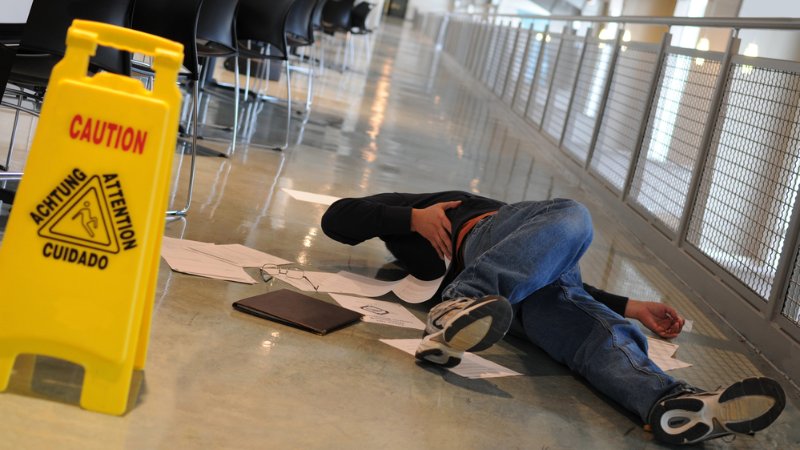If you received injuries in a place of business due to a slip and fall accident, you may be able to take legal action against the business owner. Once you have started the process, it’s natural to wonder what to expect for the slip and fall settlement timeline.
Slip and Fall Settlement Timeline Expectations
Slip and fall accidents can result in a variety of injuries, such as fractures, head injuries, back injuries, soft tissue injuries, and spinal cord injuries. If they are serious, this can result in expensive medical treatments that can add up quickly, possibly combined with time off work with no or reduced pay.
Although you want to receive compensation for damage as soon as possible, it is important to realize these cases often take time. There are many steps involved, and with complex situations, the process takes even longer. Each case varies greatly, but expect the settlement to take months and possibly years to come to a close.
Steps Involved in a Slip and Fall Case

In some cases, it may be possible to file a claim with the owner’s business insurance policy. If this goes smoothly, you may reach a fair settlement, and the slip and fall settlement timeline will be shorter. However, if the insurance company is not being fair, which is often the case, you can file a lawsuit against the property owner. It is best to hire an attorney who understands Phoenix personal injury cases such as slip and falls, as these legal teams know how to approach complex claims.
1. File a Claim
The statute of limitations is the time limit for filing a claim. In Arizona, it is two years. You will file the complaint in court against the party you are suing.
2. Receive Defendant’s Answer
Upon receipt of the complaint, the defendant has a certain number of days (typically 20) to respond. This may include admitting to, or denying, each allegation or including potential legal arguments to the allegations.
3. Go Through the Discovery Process and Prepare Case
The discovery phase and case preparation are two of the longer steps of a slip and fall case. Each side will use a variety of methods to build their case:
- Interview witnesses to the incident
- Gather evidence, such as security camera footage
- Request documents
- Take depositions
- Perform investigations
- Hire expert witnesses, such as medical and occupational experts
Depending on what proof your attorney is able to collect, they will begin to strategize and prepare interrogation questions of the defendant. This stage may last a few months to a few years, depending on the case’s complexity.
4. File Pre-Trial Motions
Either party has the opportunity to file motions with the court to resolve certain issues. One of the common pre-trial motions that the defendant files is a motion to dismiss, which typically argues the lawsuit is not legitimate due to a legal technicality. Others include a motion for summary judgment, a motion to compel, and a motion in limine. The slip and fall settlement timeline may be shorter if there are no pre-trial motions.
5. Attempt to Settle
Many slip and fall cases do not make it to court. Settlement attempts may occur during various phases of the timeline. If the case is straightforward and the other party does not dispute fault, the settlement may occur early on in the process.
However, most settlement discussions happen after the discovery phase. If the court orders it, there is a settlement conference, in which the judge conducts the proceedings to try to get the two sides to come to an agreement.
Mediation is another common way both parties attempt to settle. In this scenario, a neutral third party guides conversations between the two parties.
6. Go to Trial
If neither party can agree to a fair settlement, the case goes to trial. The judge sets the court date, which may take place a few months out. The trial is usually the quickest part of a slip and fall settlement timeline, as it usually only takes two to five days.
At the conclusion, the liable party must pay the verdict within 30 to 60 days. However, if either party disagrees with the verdict, they can appeal it, which further lengthens the timeline.
What Is Necessary To Prove Fault in a Slip and Fall Case

One of the challenges of a slip and fall case is proving fault. A business owner is responsible for maintaining a safe premises, but this is not the only factor required to prove fault. A slip and fall liability claim must prove that:
- The property owner has a duty of care for guests’ safety.
- The owner breached this duty by being negligent and not taking reasonable care.
- The breach of duty caused injury to the individual filing the lawsuit.
- The injured person sustained damages.
Business owners may be liable if they should have known about the hazardous condition, if they caused the dangerous scenario, or if they were aware of the hazard and did not take the proper steps to repair it. That the owner should have known about the condition is often the hardest condition to prove, but skilled attorneys know how to present their case.
There is also the possibility that a judge or jury will determine the plaintiff was partly at fault for the accident. For example, this may occur if the owner placed a warning sign about the hazard, but you did not see it because you were on your phone. Another example is if you were engaging in risky behaviors or activities, such as running or being under the influence, which contributed to the slip and fall.
If you are partly at fault, you still may be able to receive compensation for your injuries, but the property owner would be responsible for a lower percentage of damages.
We Can Provide an Efficient Slip and Fall Settlement Timeline
If you received injuries due to a slip and fall on someone else’s property, we at Sargon Law Group can review the situation and determine if you have enough evidence to take legal action. If so, we will do everything we can to expedite the slip and fall settlement timeline while still taking the time to build a case to get you a fair settlement. Contact us to set up an appointment.
